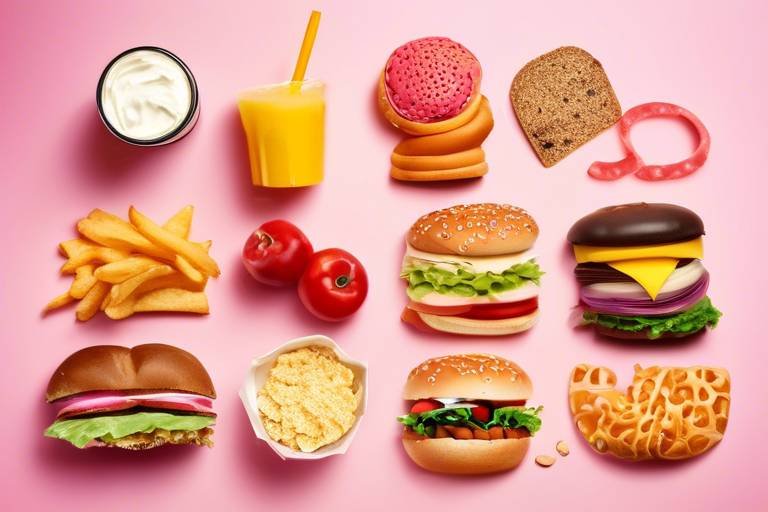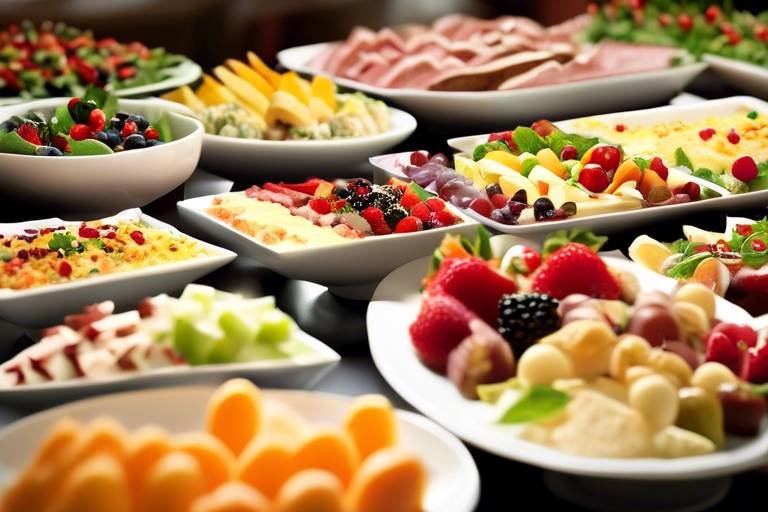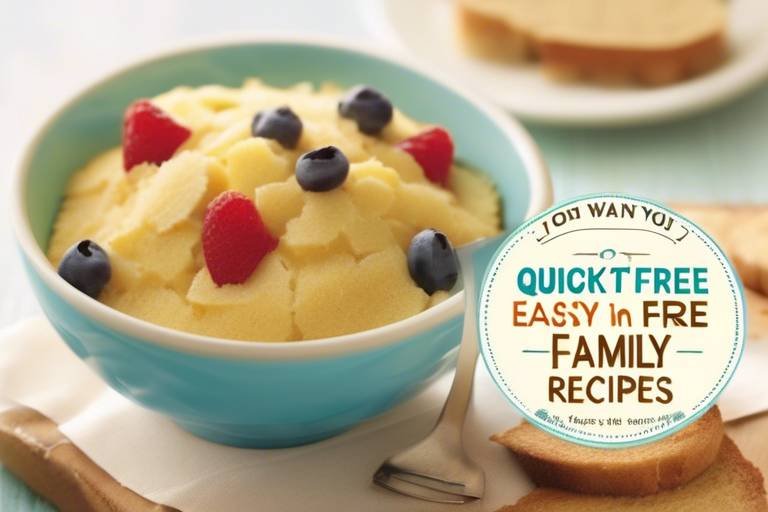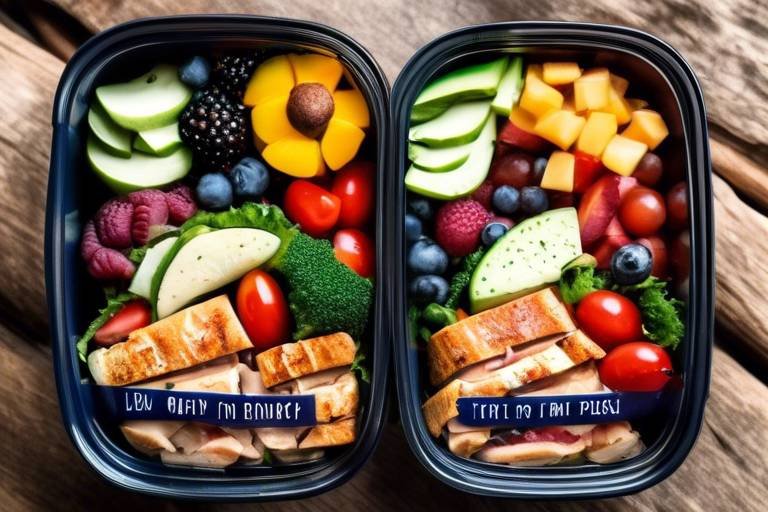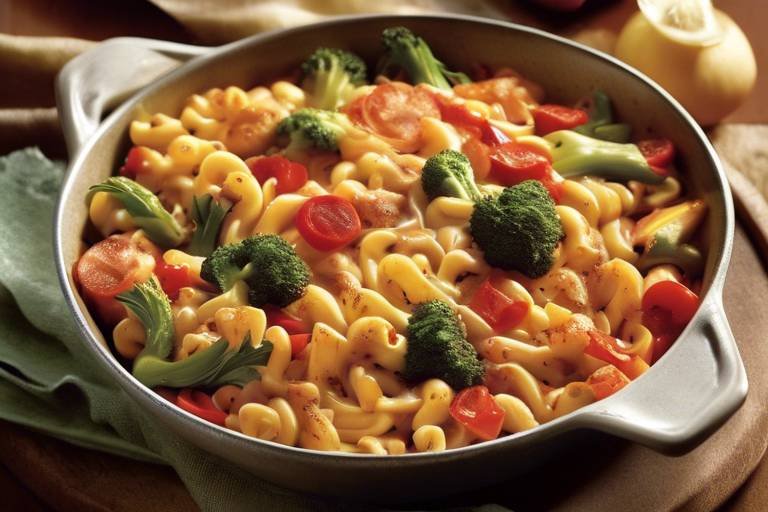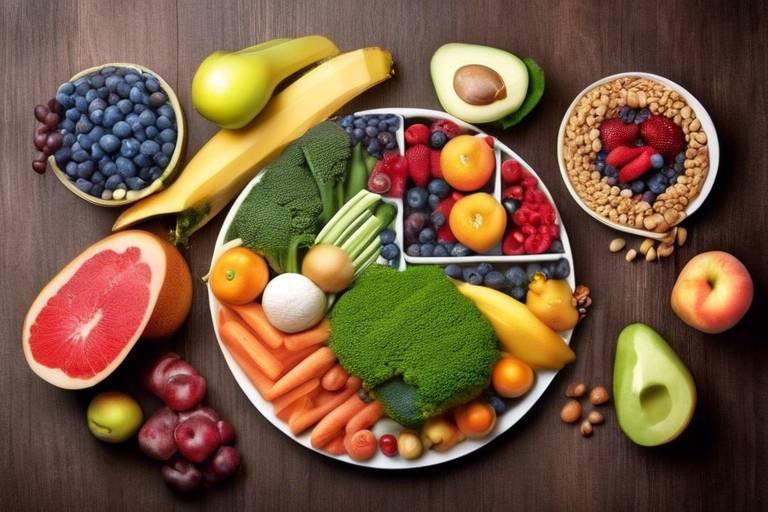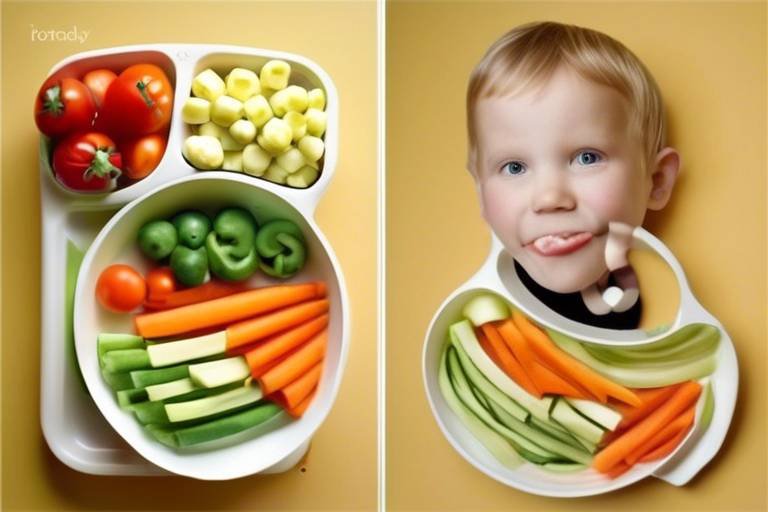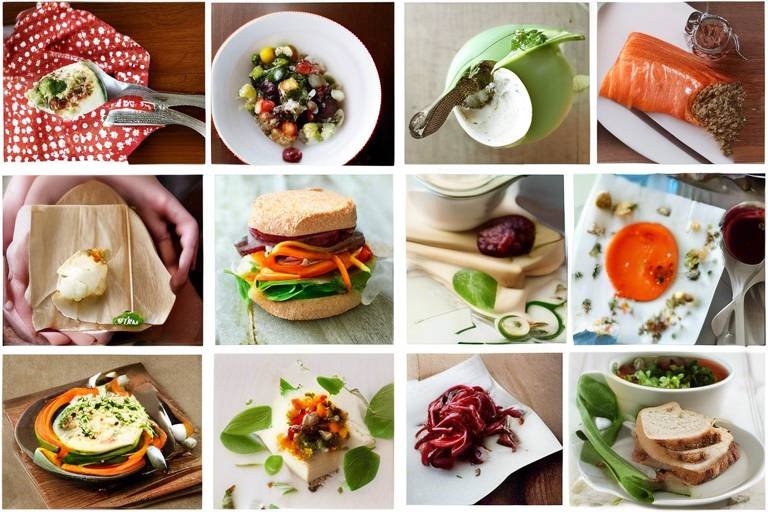Nutritious Alternatives to Unhealthy Junk Foods
In today's fast-paced world, it's all too easy to reach for a bag of chips or a candy bar when hunger strikes. But what if I told you that you could satisfy those cravings without compromising your health? This article explores healthier options to replace common junk foods, offering delicious alternatives that provide essential nutrients without sacrificing taste. Whether you're a busy professional, a parent on the go, or simply someone looking to make better choices, discovering how to make better dietary choices can transform your lifestyle. Let's dive into the world of nutritious alternatives that not only taste great but also nourish your body!
Junk food is often high in calories, sugars, and unhealthy fats, lacking essential nutrients that our bodies need to function optimally. Think of junk food as the fast track to temporary satisfaction, but at a cost to your health. Recognizing its impact on health is crucial for making informed dietary choices and promoting overall well-being. When you indulge in junk food, you might feel a quick rush of energy, but soon after, that energy plummets, leaving you feeling sluggish. This cycle can lead to weight gain, increased cravings, and a host of health issues. By understanding what junk food is and how it affects your body, you can make conscious decisions to replace it with more nutritious options.
Instead of reaching for chips or candy, consider healthier snacks like nuts, fruits, or yogurt. These alternatives provide energy and essential nutrients while satisfying cravings without the negative health effects. Imagine munching on a handful of almonds instead of a bag of potato chips. Not only do you get a satisfying crunch, but you also benefit from healthy fats and protein that keep you feeling full longer. The key is to find snacks that are both delicious and nutritious, allowing you to indulge without the guilt.
Fruits offer natural sweetness and are packed with vitamins, minerals, and fiber. They can be enjoyed fresh, dried, or blended into smoothies, making them an excellent substitute for sugary desserts. For example, have you ever tried a ripe mango or a juicy peach on a hot summer day? The burst of flavor is not only refreshing but also incredibly satisfying. Plus, fruits are versatile; you can mix them into your breakfast, add them to salads, or simply grab one on the go for a quick snack.
Frozen fruit bars made from pureed fruits are a refreshing alternative to ice cream. They provide a sweet taste without added sugars, making them a guilt-free treat on hot days. Imagine sitting on your porch, enjoying a frozen strawberry bar while the sun sets—sounds delightful, right? These bars not only cool you down but also deliver a dose of vitamins!
Combining fruits with nuts creates a satisfying snack rich in protein and healthy fats. This mix can curb hunger and provide a nutritious option compared to traditional candy bars. Think of it as nature's candy: the sweetness of dried fruits paired with the crunchiness of nuts creates a symphony of flavors and textures that will keep you coming back for more.
Vegetables can replace chips and crackers, offering a crunchy texture with fewer calories. Options like carrot sticks, cucumber slices, and bell pepper strips are both nutritious and satisfying. Picture this: instead of crunching on greasy potato chips, you're munching on crisp carrot sticks dipped in hummus. Not only is it more nutritious, but you also get to enjoy the vibrant colors and fresh flavors of vegetables that make snacking feel like a treat!
Choosing whole grains over refined carbohydrates can enhance your diet significantly. Whole grains provide fiber, which aids digestion and helps maintain steady energy levels throughout the day. Think of whole grains as the sturdy foundation of a house—without them, everything else can crumble. When you switch to whole grain options, you’re not just making a healthier choice; you’re also supporting your body’s needs for sustained energy.
Whole grain crackers or popcorn make for healthier snack alternatives. They offer a satisfying crunch and can be enjoyed plain or with healthy dips, promoting better snacking habits. Imagine hosting a movie night with friends, but instead of reaching for greasy snacks, you serve air-popped popcorn sprinkled with a dash of sea salt. It’s a simple swap that keeps everyone happy and healthy!
Making your own granola bars with oats, nuts, and dried fruits allows you to control the ingredients. These bars are a nutritious alternative to store-bought versions, often loaded with sugars and preservatives. Plus, there's something incredibly satisfying about creating your own snacks. You can customize them to your taste, adding chocolate chips or coconut flakes for a personal touch!
How you prepare food can greatly affect its healthiness. Exploring healthier cooking methods such as baking, steaming, or grilling can transform traditional junk food into nutritious meals without sacrificing flavor. For instance, instead of frying chicken, try grilling it with your favorite spices. The result? A juicy, flavorful dish that’s far healthier and just as satisfying.
- What are some easy swaps for junk food? Try replacing chips with veggie sticks and dip, or ice cream with frozen yogurt or fruit bars.
- How can I make healthier snacks at home? Simple! Combine nuts and dried fruits for a quick trail mix or make your own granola bars.
- Are whole grains really better for you? Yes! Whole grains are packed with fiber and nutrients, helping to keep you full and energized.

Understanding Junk Food
This article explores healthier options to replace common junk foods, offering delicious alternatives that provide essential nutrients without compromising on taste. Discover how to make better choices for a healthier lifestyle.
When we talk about junk food, we're usually referring to those tempting snacks and meals that are high in calories but low in nutritional value. Think about it: how often do you find yourself reaching for a bag of chips or a candy bar when you're feeling a bit peckish? These foods are often loaded with sugars, unhealthy fats, and empty calories, which can wreak havoc on our health over time. It's crucial to recognize the impact these foods have on our bodies, as they can lead to a range of health issues, including obesity, heart disease, and diabetes.
One of the biggest problems with junk food is its ability to create a cycle of cravings. The more you indulge in these sugary or fatty delights, the more your body desires them, leading to a never-ending cycle of unhealthy eating. So, how do we break this cycle? By understanding what junk food is and its effects on our health, we can make informed dietary choices that promote overall well-being.
Here’s a quick breakdown of the characteristics of junk food:
| Characteristic | Description |
|---|---|
| High in Calories | Often contains excessive calories without essential nutrients. |
| Low Nutritional Value | Lacks vitamins, minerals, and other beneficial nutrients. |
| High in Sugar | Contains added sugars that can spike blood sugar levels. |
| Unhealthy Fats | Often includes trans fats and saturated fats that can harm heart health. |
It's important to remember that while indulging in junk food occasionally is normal, making it a regular part of your diet can lead to serious health consequences. So, how can we shift our focus away from these unhealthy options? By exploring healthier alternatives and incorporating more nutrient-dense foods into our meals and snacks, we can start to feel better physically and mentally.
Instead of reaching for chips or candy, consider healthier snacks like nuts, fruits, or yogurt. These alternatives provide energy and essential nutrients while satisfying cravings without the negative health effects.
Fruits offer natural sweetness and are packed with vitamins, minerals, and fiber. They can be enjoyed fresh, dried, or blended into smoothies, making them an excellent substitute for sugary desserts.
Frozen fruit bars made from pureed fruits are a refreshing alternative to ice cream. They provide a sweet taste without added sugars, making them a guilt-free treat on hot days.
Combining fruits with nuts creates a satisfying snack rich in protein and healthy fats. This mix can curb hunger and provide a nutritious option compared to traditional candy bars.
Vegetables can replace chips and crackers, offering a crunchy texture with fewer calories. Options like carrot sticks, cucumber slices, and bell pepper strips are both nutritious and satisfying.
Choosing whole grains over refined carbohydrates can enhance your diet significantly. Whole grains provide fiber, which aids digestion and helps maintain steady energy levels throughout the day.
Whole grain crackers or popcorn make for healthier snack alternatives. They offer a satisfying crunch and can be enjoyed plain or with healthy dips, promoting better snacking habits.
Making your own granola bars with oats, nuts, and dried fruits allows you to control the ingredients. These bars are a nutritious alternative to store-bought versions, often loaded with sugars and preservatives.
How you prepare food can greatly affect its healthiness. Exploring healthier cooking methods such as baking, steaming, or grilling can transform traditional junk food into nutritious meals without sacrificing flavor.
- What are some easy swaps for junk food? You can swap chips for vegetable sticks, candy for fruit, and soda for sparkling water.
- Are all snacks bad for you? No! Healthy snacks like nuts, yogurt, and fruits can be nutritious and satisfying.
- How can I make healthier meals? Focus on whole ingredients, cook at home, and choose healthier cooking methods.

Healthier Snack Options
When those afternoon cravings hit, it can be all too tempting to reach for a bag of chips or a candy bar. However, making the switch to healthier snacks can be a game changer for your overall well-being. Instead of indulging in processed snacks that are often laden with empty calories, why not opt for options that not only satisfy your cravings but also nourish your body? Think of it this way: choosing healthier snacks is like giving your body a little love; it feels good and keeps you energized!
One of the best alternatives to junk food is to incorporate nuts into your snacking routine. Nuts are packed with protein, healthy fats, and essential nutrients that help keep you full longer. A handful of almonds or walnuts can provide a satisfying crunch and a boost of energy without the guilt associated with sugary snacks. If you find yourself craving something sweet, consider pairing your nuts with fruits. The combination of fruits and nuts not only enhances flavor but also creates a powerhouse of nutrients. For instance, a mix of dried apricots and pecans can be a delightful treat that curbs your hunger while delivering a dose of vitamins and minerals.
Speaking of fruits, they are nature's candy! With their natural sweetness, fruits can easily replace sugary desserts. Whether you enjoy them fresh, dried, or blended into a smoothie, fruits are incredibly versatile. For a refreshing twist, try making frozen fruit bars at home. Simply puree your favorite fruits and freeze them in molds for a delicious treat that’s free from added sugars. Not only are they a great way to cool down on a hot day, but they also provide vitamins and hydration.
Another fantastic option is to swap out chips for crunchy vegetables. Imagine munching on carrot sticks, cucumber slices, or bell pepper strips instead of greasy snacks! These veggies are not only low in calories but also high in fiber, making them an excellent choice for snacking. You can enhance the experience by pairing them with healthy dips like hummus or guacamole. This combination not only adds flavor but also boosts the nutritional value of your snack. It’s like turning your snack time into a mini veggie party!
In summary, the next time you feel the urge to snack, remember that there are plenty of delicious and nutritious alternatives to junk food. By choosing options like nuts, fruits, and vegetables, you can satisfy your cravings while fueling your body with essential nutrients. So, why not give these healthier snacks a try? Your body will thank you!

Fruits as Sweet Treats
When it comes to satisfying a sweet tooth, fruits are nature's candy! They offer a burst of natural sweetness that can easily replace those sugary snacks that often leave you feeling sluggish and guilty. Imagine biting into a juicy mango or savoring the tartness of a ripe raspberry; these delightful fruits not only taste amazing but are also packed with essential vitamins, minerals, and fiber. Instead of reaching for that chocolate bar, why not grab an apple or a handful of strawberries? They can be enjoyed in countless ways, making them a versatile and healthy alternative.
One fantastic way to enjoy fruits is by incorporating them into your daily routine. You can have them fresh, toss them into a smoothie for a refreshing drink, or even dry them for a chewy snack. For example, dried apricots or figs can provide a sweet energy boost without the added sugars found in many processed snacks. Plus, blending fruits into smoothies can create a creamy, indulgent treat that feels like dessert but is actually nourishing your body.
Speaking of treats, have you ever tried frozen fruit bars? These delightful creations are made from pureed fruits and can serve as a refreshing alternative to ice cream. They are not only lower in calories but also free from added sugars, making them a guilt-free option, especially during those hot summer days. It's like enjoying a popsicle, but with all the benefits of fruit!
Another delicious option is mixing fruits with nuts. Imagine a handful of almonds paired with slices of banana or a medley of dried fruits mixed with walnuts. This combination not only satisfies your sweet cravings but also provides a dose of protein and healthy fats. It's a snack that keeps you full and energized, unlike traditional candy bars that leave you wanting more.
In summary, fruits are a fantastic way to satisfy your sweet cravings while providing your body with essential nutrients. Whether you enjoy them fresh, frozen, or mixed with nuts, they offer a delicious alternative to processed sweets. So, the next time you're tempted by junk food, remember that a sweet treat can be as simple as reaching for a piece of fruit!
- Are fruits high in sugar? While fruits do contain natural sugars, they also come with fiber, vitamins, and minerals that make them a healthy choice. Moderation is key!
- Can I eat fruits if I’m trying to lose weight? Absolutely! Fruits are low in calories and high in nutrients, making them an excellent choice for weight loss. Just be mindful of portion sizes.
- What are some easy ways to incorporate more fruits into my diet? Try adding fruits to your breakfast cereal, blending them into smoothies, or snacking on them throughout the day instead of processed snacks.
- Are dried fruits as healthy as fresh fruits? Dried fruits can be healthy but watch out for added sugars. They are more calorie-dense, so enjoy them in moderation.

Frozen Fruit Bars
If you're searching for a refreshing and guilt-free treat to beat the heat, look no further than frozen fruit bars! These delightful snacks are not only delicious but also incredibly easy to make at home. Imagine biting into a cool, fruity bar on a hot summer day; it’s like a burst of sunshine in your mouth! Unlike traditional ice creams and popsicles that are loaded with added sugars and artificial ingredients, frozen fruit bars are made from pureed fruits, which means you're indulging in the natural sweetness of fruits without the guilt.
Making your own frozen fruit bars allows you to control the ingredients completely. You can mix and match your favorite fruits, such as strawberries, mangoes, or blueberries, and even add a splash of coconut water or yogurt for creaminess. The beauty of these bars lies in their versatility. You can create a colorful array of flavors that not only look appealing but also cater to your taste buds. Plus, they are packed with essential vitamins and minerals, making them a nutritious alternative to processed snacks.
To make your own frozen fruit bars, follow these simple steps:
- Choose your favorite fruits and chop them into smaller pieces.
- Blend the fruits until smooth, adding a little honey or agave syrup if you prefer extra sweetness.
- Pour the mixture into molds, inserting sticks if desired.
- Freeze for several hours until solid.
Not only are frozen fruit bars a great way to cool off, but they also provide a perfect opportunity to sneak in some extra servings of fruit into your diet. For those who are health-conscious, they are a fantastic option that satisfies your sweet tooth without the unnecessary calories. You can even experiment with different combinations to find your perfect flavor profile. So, why not give them a try and enjoy a deliciously refreshing snack that your body will thank you for?
- How long do frozen fruit bars last in the freezer? Typically, they can last up to 3 months if stored properly in an airtight container.
- Can I use frozen fruits instead of fresh? Absolutely! Using frozen fruits can make the process easier, and they still provide great flavor and nutrition.
- Are frozen fruit bars suitable for kids? Yes! They are a healthy treat that kids will love, making them a great alternative to sugary snacks.

Fruit and Nut Mixes
When it comes to snacking, are a powerhouse of flavor and nutrition! Imagine a delightful blend of sweet, chewy fruits and crunchy, satisfying nuts coming together in one bowl. This combination not only tantalizes your taste buds but also provides a myriad of health benefits. Nuts are known for their healthy fats, which are essential for heart health, while fruits bring a burst of natural sweetness and essential vitamins to the table. It's like a mini celebration of nature's goodness in every handful!
One of the best things about fruit and nut mixes is their versatility. You can create your own unique blend based on your personal preferences or what you have on hand. For instance, consider mixing almonds with dried cranberries for a sweet and tangy flavor explosion. Or how about pairing walnuts with banana chips for a delightful crunch? The possibilities are endless! Plus, they are incredibly easy to prepare. Just grab your favorite nuts and dried fruits, toss them together, and voilà! You have a nutritious snack ready to go.
Not only are these mixes delicious, but they also provide a great source of energy. Whether you're heading out for a hike, looking for a quick pick-me-up during the workday, or simply craving something tasty, a handful of fruit and nuts can do the trick. You’ll find that the combination of protein, fiber, and healthy fats keeps you feeling fuller for longer, helping to curb those pesky cravings that often lead us back to unhealthy snacks.
To make it even more interesting, consider the nutritional benefits of some common ingredients in fruit and nut mixes:
| Ingredient | Nutritional Benefit |
|---|---|
| Almonds | Rich in vitamin E, magnesium, and fiber |
| Walnuts | High in omega-3 fatty acids and antioxidants |
| Dried Cranberries | Good source of vitamin C and fiber |
| Banana Chips | Provides potassium and a natural sweetness |
So, next time you're tempted to reach for that sugary candy bar, think about whipping up a fruit and nut mix instead. It’s not just a snack; it’s a step towards a healthier lifestyle! You’ll be surprised at how satisfying and energizing it can be. Plus, it’s a great way to incorporate more whole foods into your diet without sacrificing taste. With just a little creativity, you can turn a simple snack into a delightful experience that nourishes both your body and soul.
1. Can I use fresh fruits in my mixes?
While fresh fruits are delicious and nutritious, they may not be as convenient for snacking on-the-go. Dried fruits are often used in mixes for their longer shelf life and portability. However, feel free to experiment with fresh fruits when you’re at home!
2. How can I store my fruit and nut mixes?
For optimal freshness, store your mixes in an airtight container in a cool, dry place. This will help maintain their crunchiness and flavor for a longer period.
3. Are there any allergens I should be aware of?
Yes, nuts are common allergens. If you’re preparing mixes for others, be sure to ask about any nut allergies. You can also substitute nuts with seeds, such as pumpkin or sunflower seeds, for a similar crunch without the allergens.

Vegetables for Crunch
When it comes to satisfying that craving for something crunchy, vegetables are your best friend! Instead of reaching for those greasy chips that leave you feeling sluggish and guilty, why not opt for a colorful array of fresh veggies? Not only do they offer a delightful crunch, but they also come packed with essential vitamins and minerals that your body craves. Think about it: a crisp carrot stick or a refreshing cucumber slice can be just as satisfying, if not more, than a handful of potato chips. Plus, you can dip them in your favorite hummus or yogurt-based dip, turning a simple snack into a gourmet experience.
Imagine crunching into a sweet bell pepper strip or munching on some radish slices. These vibrant vegetables not only add a fun pop of color to your plate but also bring a burst of flavor that can easily rival any processed snack. They are low in calories and high in nutrients, making them a prime choice for anyone looking to maintain a healthy lifestyle without sacrificing taste. If you're feeling adventurous, try roasting some broccoli or cauliflower with a sprinkle of olive oil and your favorite spices. The result? A crunchy, flavorful side dish that pairs perfectly with any meal!
Here’s a quick comparison of some popular crunchy vegetable options:
| Vegetable | Calories (per 100g) | Nutritional Benefits |
|---|---|---|
| Carrot Sticks | 41 | High in beta-carotene, fiber, and antioxidants |
| Cucumber Slices | 16 | Hydrating, low in calories, and contains vitamins K and C |
| Bell Pepper Strips | 31 | Rich in vitamins A and C, and antioxidants |
| Radish Slices | 16 | High in vitamin C and low in calories |
Incorporating these crunchy vegetables into your diet is not only easy but can also be a fun way to explore new flavors and textures. Try pairing them with different dips or adding them to salads for an extra crunch. You might be surprised at how satisfying they can be! So next time you feel the urge to snack, remember that the world of vegetables offers a delightful crunch that can keep your taste buds happy and your body healthy.
- Can I eat vegetables as a snack every day? Absolutely! Vegetables are a nutritious and low-calorie snack option that can be enjoyed daily.
- What are some good dips for vegetables? Hummus, guacamole, and yogurt-based dips are excellent choices that complement crunchy veggies.
- Are frozen vegetables just as healthy as fresh ones? Yes! Frozen vegetables retain most of their nutrients and can be a convenient option when fresh ones are not available.

Whole Grains Instead of Refined Carbs
When it comes to making healthier dietary choices, one of the most impactful changes you can make is swapping out refined carbs for whole grains. Refined carbohydrates, such as white bread, pastries, and many breakfast cereals, undergo processing that strips away their natural nutrients and fiber. This results in a product that is not only lower in nutritional value but also causes rapid spikes in blood sugar levels, leading to energy crashes and increased hunger. In contrast, whole grains retain the bran, germ, and endosperm, offering a wealth of nutrients and health benefits.
Whole grains are rich in fiber, which plays a crucial role in digestion and helps maintain a feeling of fullness, making it easier to manage weight. They also provide essential vitamins and minerals, such as B vitamins, iron, magnesium, and antioxidants, that contribute to overall health. By choosing whole grains, you’re not just making a dietary choice; you’re investing in your long-term well-being. For instance, studies have shown that diets rich in whole grains can lower the risk of heart disease, type 2 diabetes, and certain types of cancer.
Here are some popular whole grains you can incorporate into your meals:
- Quinoa: A complete protein that contains all nine essential amino acids.
- Brown Rice: A versatile grain that can be used in a variety of dishes.
- Oats: Perfect for breakfast, oats are filling and can be customized with fruits and nuts.
- Barley: A chewy grain that works well in soups and salads.
- Whole Wheat: Use whole wheat flour for baking to increase fiber content.
In addition to being nutritious, whole grains can be incredibly delicious! They can be used in a variety of recipes that are both satisfying and flavorful. For example, consider making a hearty quinoa salad with fresh vegetables and a light vinaigrette, or enjoy a warm bowl of oatmeal topped with your favorite fruits and nuts. The options are endless!
It's also important to be aware of how to identify whole grains in the grocery store. Look for products that list "100% whole grain" or "whole grain" as the first ingredient on the label. Be cautious of terms like "multi-grain" or "made with whole grains," as these can sometimes still contain refined grains. Always check the nutrition label to ensure you're making the healthiest choice possible.
In summary, replacing refined carbs with whole grains is a simple yet powerful way to enhance your diet. Not only do whole grains provide essential nutrients, but they also keep you feeling fuller for longer, help regulate blood sugar levels, and support overall health. So the next time you’re at the grocery store or planning a meal, remember to opt for whole grains and enjoy the delicious benefits they bring to your table!
1. What are whole grains?
Whole grains include all parts of the grain kernel: the bran, germ, and endosperm. Examples include brown rice, whole wheat, oats, and quinoa.
2. Why are whole grains better than refined grains?
Whole grains are higher in fiber, vitamins, and minerals compared to refined grains, which have been processed to remove the bran and germ. This makes whole grains more nutritious and beneficial for health.
3. How can I incorporate more whole grains into my diet?
You can start by swapping out white bread for whole grain bread, choosing brown rice instead of white rice, and adding whole grains like quinoa or barley to salads and soups.
4. Are whole grains gluten-free?
Not all whole grains are gluten-free. Grains like wheat and barley contain gluten, while others like quinoa, brown rice, and millet are naturally gluten-free.
5. How much whole grain should I eat?
It is recommended that at least half of the grains you consume each day be whole grains. Aim for about 3 to 5 servings of whole grains daily, depending on your calorie needs.

Whole Grain Snacks
When it comes to snacking, choosing can make a world of difference for your health. Unlike their refined counterparts, whole grains retain the bran and germ, which means they are packed with fiber, vitamins, and minerals. This not only aids in digestion but also keeps you feeling full longer, reducing the temptation to reach for those unhealthy options. Imagine munching on a crunchy snack that not only satisfies your cravings but also nourishes your body!
Whole grain snacks come in various forms, and they can be just as delicious as traditional junk food. For instance, whole grain crackers can be enjoyed plain or paired with your favorite dips, such as hummus or guacamole. They provide that satisfying crunch without the guilt of consuming empty calories. If you’re a fan of popcorn, opting for air-popped whole grain popcorn can be a fantastic alternative to chips. You can season it with a sprinkle of your favorite spices or a dash of olive oil for an extra flavor kick.
Additionally, consider making your own whole grain snacks at home. Homemade granola bars are a perfect example. By combining oats, nuts, seeds, and a touch of honey or maple syrup, you can create a delicious and nutritious snack that is free from preservatives and excessive sugars often found in store-bought varieties. Not only do these bars provide sustained energy, but they also allow you to customize the ingredients to suit your taste preferences.
Here’s a quick look at some popular whole grain snack options:
| Snack | Benefits |
|---|---|
| Whole Grain Crackers | High in fiber, great with dips |
| Air-Popped Popcorn | Low-calorie, whole grain goodness |
| Homemade Granola Bars | Customizable, nutrient-rich |
| Whole Grain Rice Cakes | Light, versatile, can be topped |
Incorporating whole grain snacks into your diet can be a fun and delicious way to boost your nutrition. By making simple swaps, you can enjoy the crunch and flavor you love while also giving your body the nutrients it craves. So next time you’re feeling snacky, reach for a whole grain option and feel good about your choice!
Q: What are whole grains?
Whole grains include the entire grain kernel, meaning they contain the bran, germ, and endosperm. Examples include oats, brown rice, quinoa, and whole wheat.
Q: Why are whole grains better than refined grains?
Whole grains are more nutritious as they retain fiber, vitamins, and minerals that are often lost during the refining process. This makes them beneficial for digestion and overall health.
Q: Can I find whole grain snacks at the store?
Yes! Many grocery stores offer a variety of whole grain snacks, including crackers, popcorn, and granola bars. Just be sure to read the labels to confirm they are made from whole grains.
Q: How can I make my own whole grain snacks?
You can create your own snacks by using whole grain ingredients like oats, whole wheat flour, and brown rice. Recipes for granola bars, muffins, and energy bites are widely available online.

Homemade Granola Bars
When it comes to snacking, are a game changer! Not only do they allow you to control the ingredients, but they also provide a delicious and nutritious alternative to store-bought versions that are often packed with sugars and preservatives. Imagine biting into a chewy, sweet bar that’s bursting with flavors and textures, all while knowing exactly what went into it. Sounds tempting, right?
Creating your own granola bars is simpler than you might think. You can customize them to suit your taste preferences and dietary needs. The basic ingredients usually include oats, nuts, seeds, and a natural sweetener like honey or maple syrup. You can also add extras like dried fruits, chocolate chips, or even a sprinkle of cinnamon for that extra kick. The possibilities are endless!
Let’s break down a simple recipe to get you started:
| Ingredients | Quantity |
|---|---|
| Rolled oats | 2 cups |
| Honey or maple syrup | 1/2 cup |
| Nut butter (like almond or peanut) | 1/2 cup |
| Chopped nuts (your choice) | 1/2 cup |
| Dried fruits (like cranberries or raisins) | 1/2 cup |
| Chocolate chips (optional) | 1/4 cup |
To prepare, simply combine all the ingredients in a large bowl until well mixed. Next, line a baking dish with parchment paper and press the mixture evenly into the bottom. Bake at 350°F (175°C) for about 20-25 minutes, or until golden brown. Once cooled, cut into bars and store them in an airtight container. They’ll keep for about a week, but honestly, they might not last that long!
Not only are these bars perfect for on-the-go snacking, but they also make a great breakfast option when you’re running late. Just grab a bar, and you’re set! Plus, they’re a fantastic way to fuel up before or after a workout. The combination of proteins, healthy fats, and carbohydrates will keep your energy levels up and your cravings in check.
So, why settle for those sugary, processed snacks when you can whip up a batch of these delightful homemade granola bars? They’re not just good for your body; they’re also a treat for your taste buds. Give it a try, and you might just find that you never want to go back to store-bought again!
Q: How long do homemade granola bars last?
A: When stored in an airtight container, homemade granola bars can last up to a week at room temperature. For longer storage, consider refrigerating them, which can extend their freshness for up to two weeks.
Q: Can I make these bars gluten-free?
A: Absolutely! Just make sure to use certified gluten-free oats and check that all other ingredients are gluten-free as well.
Q: What can I substitute for honey?
A: If you prefer a vegan option, you can substitute honey with maple syrup, agave nectar, or brown rice syrup.

Healthy Cooking Methods
When it comes to transforming our meals from unhealthy to wholesome, the way we cook plays a pivotal role. It's not just about what we eat, but how we prepare it that can make all the difference. Imagine biting into a juicy, baked chicken breast instead of a greasy fried one; the flavors can be just as delightful, but the health benefits are miles apart. can help preserve the nutrients in our food while also enhancing flavor without adding unnecessary calories or unhealthy fats.
One of the most popular methods is baking. This technique allows food to cook evenly while retaining moisture, making it a fantastic option for proteins like fish and chicken. Baking can also be a great way to prepare vegetables, resulting in a delicious caramelization that brings out their natural sweetness. Think about roasted sweet potatoes or baked zucchini—these dishes can easily replace their fried counterparts while still satisfying your cravings.
Another excellent method is steaming. This cooking technique involves using water vapor to cook food, which helps maintain its vitamins and minerals. Steaming vegetables like broccoli or carrots not only keeps them vibrant and crunchy but also ensures they retain their nutritional value. Plus, you can easily add herbs and spices to the water for an extra flavor boost without the added calories.
Grilling is another fantastic way to prepare food healthily. It allows excess fat to drip away while imparting a smoky flavor that’s hard to beat. Whether you're grilling lean meats, fish, or even vegetables, the results are often mouthwatering. Just picture a perfectly grilled vegetable skewer bursting with flavor—it's a healthy choice that doesn’t skimp on taste!
For those who love a bit of crunch, consider air frying. This method uses hot air circulation to cook food, creating a crispy texture similar to frying but with far less oil. You can enjoy your favorite snacks like french fries or chicken wings without the guilt. The air fryer can become your best friend in the kitchen, allowing you to indulge in your favorite treats while sticking to your health goals.
Lastly, let’s not forget about slow cooking. This method is perfect for busy individuals who want to come home to a warm, nutritious meal. By cooking food at a low temperature for an extended period, you allow flavors to meld beautifully while keeping the food tender and juicy. Think of a hearty vegetable stew or a lean meat dish simmering all day; it’s a comforting way to enjoy healthy meals without the fuss.
Incorporating these cooking methods into your daily routine can be a game-changer for your health. Not only do they help you create meals that are rich in nutrients, but they also ensure that you enjoy every bite. So, next time you’re in the kitchen, think about how you can swap out those unhealthy cooking techniques for healthier ones. Your body (and taste buds) will thank you!
- What is the healthiest cooking method?
Steaming is often considered one of the healthiest cooking methods as it preserves the most nutrients in vegetables and proteins.
- Can I still enjoy fried foods while eating healthy?
Yes! Using an air fryer allows you to enjoy crispy fried foods with significantly less oil, making it a healthier alternative.
- What are some easy healthy recipes for beginners?
Start with simple grilled chicken, baked sweet potatoes, or steamed vegetables. These recipes require minimal ingredients and are easy to prepare.
Frequently Asked Questions
- What are some healthier alternatives to chips?
Instead of reaching for chips, consider snacking on crunchy vegetables like carrot sticks, cucumber slices, or bell pepper strips. These options provide a satisfying crunch with fewer calories and more nutrients!
- How can I satisfy my sweet tooth without junk food?
Fruits are a fantastic way to satisfy your sweet cravings! They are naturally sweet and packed with vitamins and fiber. You can enjoy them fresh, dried, or even in smoothies for a delicious treat!
- Are whole grains really better than refined carbs?
Absolutely! Whole grains are rich in fiber, which aids digestion and keeps your energy levels steady throughout the day. Opting for whole grain snacks like crackers or popcorn can make a significant difference in your diet.
- What’s a good homemade snack option?
Homemade granola bars are a great choice! By using oats, nuts, and dried fruits, you can create a nutritious snack that’s free from the added sugars and preservatives often found in store-bought versions.
- How can I make my cooking healthier?
Switching up your cooking methods can have a big impact! Try baking, steaming, or grilling instead of frying. These methods can help you create flavorful meals without the extra calories and unhealthy fats.
- Can I still enjoy desserts while being healthy?
Definitely! You can enjoy desserts made from frozen fruit bars or yogurt with fresh fruits. These options provide sweetness without the guilt and are loaded with nutrients!

